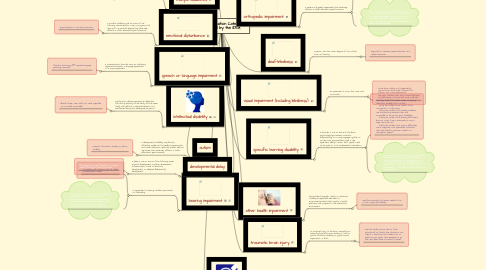
1. autism
1.1. a developmental disability significantly affecting verbal and nonverbal communication and social interaction, generally evident before age three, that adversely affects a child’s educational performance.
1.1.1. present information visually as well as verbally
2. deafness
2.1. a hearing impairment so severe that a child is impaired in processing linguistic information through hearing, with or without amplification
2.1.1. special education services
3. emotional disturbance
3.1. a condition exhibiting one or more of the following characteristics over a long period of time and to a marked degree that adversely affects a child’s educational performance:
3.1.1. psychological or counseling services
4. hearing impairment
4.1. an impairment in hearing, whether permanent or fluctuating
4.1.1. consistent, and conscious use of visible communication modes
4.1.2. A student in one of the schools I worked had a reputation for "not listening" and not following instructions after an assessment it was recommended he used a headphone like sound device which has since made the teaching and learning a better experience.
5. intellectual disability
5.1. significantly subaverage general intellectual functioning, existing concurrently [at the same time] with deficits in adaptive behavior and manifested during the developmental period
5.1.1. Break longer, new tasks into small steps Be as concrete as possible
6. speech or language impairment
6.1. a communication disorder such as stuttering, impaired articulation, a language impairment, or a voice impairment
6.1.1. Assistive technology (AT) speech-language pathology services
7. developmental delay
7.1. a delay in one or more of the following areas: physical development; cognitive development; communication; social or emotional development; or adaptive [behavioral] development
7.1.1. Assistive technology (devices a child might need) Audiology or hearing services
8. multiple disabilities
8.1. concomitant [simultaneous] impairments (such as intellectual disability-blindness, intellectual disability-orthopedic impairment, etc.), the combination of which causes such severe educational needs that they cannot be accommodated in a special education program solely for one of the impairments
8.1.1. Consider assistive technology (AT). Allow partial participation, as necessary
9. deaf-blindness
9.1. a person who has some degree of loss in both vision and hearing
9.1.1. important to receive special education and related services
10. other health impairment
10.1. having limited strength, vitality, or alertness, including a heightened alertness to environmental stimuli, that results in limited alertness with respect to the educational environment
10.1.1. must be assessed in all areas related to his or her suspected disability
11. specific learning disability
11.1. a disorder in one or more of the basic psychological processes involved in understanding or in using language, spoken or written, that may manifest itself in the imperfect ability to listen, think, speak, read, write, spell, or to do mathematical calculations.
11.1.1. breaking tasks into smaller steps, and giving directions verbally and in writing; giving the student more time to finish schoolwork or take tests; letting the student with reading problems use instructional materials that are accessible to those with print disabilities; letting the student with listening difficulties borrow notes from a classmate or use a tape recorder; and letting the student with writing difficulties use a computer with specialized software that spell checks, grammar checks, or recognizes speech.
11.1.2. I have taught several students who have been diagnosed with various learning disabilities. Some of the students in this category had rich imagination and with the help of the SST team who provided ways to modify their introductions, I was able to deliver the lessons with success.
12. traumatic brain injury
12.1. an acquired injury to the brain caused by an external physical force, resulting in total or partial functional disability or psychosocial impairment, or both
12.1.1. Give the student more time to finish schoolwork and tests. Give directions one step at a time.Show the student how to perform new tasks. Give examples to go with new ideas Have consistent routines.
13. visual impairment (including blindness).
13.1. an impairment in vision that, even with correction
13.1.1. move about safely and independently; use assistive technologies designed for children with visual impairments; use what residual vision they have effectively and efficiently; and read and write in Braille,
14. orthopedic impairment
14.1. a severe orthopedic impairment that adversely affects a child’s educational performance
14.1.1. Instruction focused on development of gross and fine motor skills
14.1.2. One of my students loved art but, had a severe orthopedic impairment. She was able to create using special scissors and other materials which didn't require a lot of fine motor skills which made her and the teaching team externally excited.

